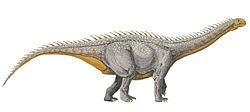Discovery
The holotype of Bashunosaurus, KM 20100, was discovered in sediments of the lower Shaximiao Formation in Maanping, Sichuan Province, China. It consists of six cervical vertebrae, eight dorsal vertebrae, a partial left scapula, and a right humerus, ulna, ilium, femur, tibia, and fibula. An additional right ilium, specimen KM 20103, was assigned as a paratype. [2]
History
The name "Bashunosaurus kaijiangensis" first appeared in Ouyang's description of Abrosaurus in 1989, [3] although without a description or diagnosis, making it a nomen nudum (i.e. a nickname that is unavailable for use as an actual scientific name). Li et al. (1999), however, attribute the naming to "Kuang, 1996", still considering it a nomen nudum. [4] Although it was finally formally named by Kuang in 2004, [2] George Olshevsky's influential online Dinosaur Genera List continued to list it as a nomen nudum and possible synonym of Datousaurus . [5] It was largely ignored in modern literature until Dai et al.'s description of Yuzhoulong in 2022, where it is discussed. [6]
Classification
The precise classification of Bashunosaurus is unknown, with different authors proposing different ideas. Li et al. (1999) consider it a camarasaurid, [4] while Kuang (2004) gives a more precise position in the Camarasaurinae, more derived than Abrosaurus but more basal than Camarasaurus . [2] Molina-Perez and Larramendi (2020) list it as a primitive neosauropod similar to Bellusaurus , Daanosaurus , Dashanpusaurus and Klamelisaurus , although they comment that it is also "similar to Abrosaurus and Datousaurus ". [7] Dai et al. (2022) compare the taxon to Yuzhoulong , noting the fact it was described as a macronarian, although they caution that a reappraisal is needed to confirm this in a cladistic context. [6] [8]
This page is based on this
Wikipedia article Text is available under the
CC BY-SA 4.0 license; additional terms may apply.
Images, videos and audio are available under their respective licenses.












